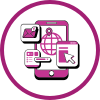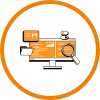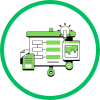The 80/20 shift requires agencies to allocate 80% of funds to direct care and only 20% to overhead. Early action through lean processes, integrated software, and workforce investment ensures compliance, operational efficiency, and long-term resilience for HCBS providers.
Introduction
The Home and Community-Based Services (HCBS) sector is undergoing a pivotal transformation: the 80/20 shift, which requires agencies to allocate 80% of funds to direct caregiver compensation and client services, leaving only 20% for administrative and overhead costs. Providers operating under tight margins face pressure to optimize workflows, streamline costs, and enhance caregiver retention.
Falling behind could result in financial penalties, regulatory scrutiny, and reputational risks. Agencies can reference the CMS HCBS program guidance to understand compliance requirements.
This article serves as a tactical playbook, showing how HCBS Software and technology-driven strategies can maximize direct care allocation, ensure compliance, and position agencies for long-term growth.
The 80/20 Rule: Why It Matters, and What’s Changing
Why the 80/20 Rule Matters
The 80/20 rule addresses challenges in the direct care workforce, including low wages, high turnover, and workforce shortages. By directing a significant portion of Medicaid funds toward direct care worker compensation, agencies can:
Enhance Care Quality: Investing in the workforce improves training and service quality for HCBS recipients.
Increase Workforce Stability: Competitive compensation reduces turnover, creating a consistent and experienced workforce.
Address Workforce Shortages: Attracting and retaining skilled caregivers meets the growing demand for HCBS services.
These goals align with the Ensuring Access to Medicaid Services Final Rule (CMS-2442-F), which emphasizes access, quality, and accountability in Medicaid-funded HCBS.
What’s Changing: Key Dates and Requirements
The 80/20 rule has specific milestones:
July 9, 2024: The Ensuring Access to Medicaid Services Final Rule (CMS-2442-F) is in effect, introducing the 80/20 requirement. At least 80% of Medicaid payments for homemakers, home health aide, and personal care services must be allocated to direct care worker compensation.
July 9, 2028: States must begin annual reporting on the percentage of Medicaid payments spent on direct care compensation for relevant HCBS services.
July 9, 2030: The minimum payment requirement is enforced, ensuring at least 80% of Medicaid payments for specified HCBS go toward direct care worker wages.
These dates give states and agencies a structured timeline to adjust payment structures, optimize operations, and ensure compliance.
Preparing for the 80/20 Rule
Before making operational changes for the 80/20 shift, agencies must first understand their current baseline. A structured diagnostic phase highlights inefficiencies and pinpoints opportunities for improvement.
1. Financial & Cost Audit
Start by breaking down revenue and expenses by category, then calculate your current “direct care share.” This reveals whether you are close to meeting the 80/20 threshold. Pay special attention to overhead-heavy cost centers such as administration, HR, or compliance that may be consuming more than their fair share of resources. For deeper insights into federal oversight, see the CMS Medical Loss Ratio Data and System Resources.
2. Workflow & Process Mapping
Evaluate critical processes like intake, scheduling, payroll, billing, compliance, and reporting. Use process-mapping frameworks (SIPOC, value-stream mapping) to uncover bottlenecks, rework cycles, and decision delays. Visualizing workflows often exposes inefficiencies hidden in day-to-day operations.
3. Technology & Systems Assessment
Inventory your current systems - scheduling, HR, billing, EHR, EVV, reporting – and identify silos, duplicated data entry, and manual handoffs. A gap analysis highlights weak spots in integration, automation, and scalability, providing clarity on where technology can deliver quick wins.
4. People, Culture & Skills Assessment
Analyze turnover rates, training investments, and staff satisfaction to understand workforce dynamics. Assess whether your team has the skills for analytics and process improvement, and gauge change readiness. Strong leadership alignment and cultural buy-in are essential for successful transformation. Reference the State Operations Manual - Chapter 2 for guidance on compliance and certification.
Strategic Pillars for Operational Efficiency
The 80/20 shift challenges agencies to maximize resources for direct care while minimizing overhead. Success requires strategic, technology-driven approaches. Below are six operational pillars, enhanced with CareVoyant’s all-in-one HCBS software:
1. Lean & Standardized Processes
Automating repetitive tasks and standardizing workflows reduces overhead. CareVoyant helps agencies implement all-in-one home care software to streamline intake-to-billing processes and reduce errors. Standard operating procedures supported by built-in validations (e.g., scheduling outside authorizations) cut errors while a continuous improvement mindset ensures ongoing refinement.
2. Integrated Software Platform Strategy
A unified tech stack beats siloed systems. CareVoyant provides a single patient record across HCBS, home health, private duty, and pediatric care, linking intake, scheduling, clinical documentation, billing, and payroll. Features like shift-based scheduling, authorization & plan-of-care management, EVV via CV Mobile, and billing & revenue cycle management ensure interoperability and compliance.
3. Data Capture, Analytics, & Reporting Infrastructure
Effective optimization depends on actionable insights. CareVoyant’s reports and dashboards deliver real-time visibility into hours worked, no-shows, overtime, variances, and revenue cycles. Agencies gain the ability to drill down into root causes and make evidence-based decisions. Explore real-time dashboards for HCBS agencies to support predictive analytics and financial planning.
4. Workforce Strategy & Caregiver Investment
Agencies thrive when caregivers are supported and retained. CareVoyant’s scheduling system optimizes caregiver assignments, factoring in overtime, travel, and preferences, while mobile documentation tools and empower aides at the point of care. Payroll integration ensures accurate, timely compensation. Care coordination features help agencies enhance retention with improved communication and predictable workloads.
5. Compliance, Risk, & Governance
The 80/20 rule increases accountability. CareVoyant automates compliance checks by linking authorizations, scheduling, and billing, preventing out-of-pocket visits. EVV with GPS validation ensures visits are accurately documented. Audit trails, real-time alerts, and incident reporting reduce regulatory risk. Refer EVV compliance and audit readiness for best practices.
6. Payer / MCO Alignment & Value Propositions
Payers seek partners who deliver outcomes, not just services. CareVoyant equips agencies with the ability to demonstrate value through clinical documentation, metrics, and operational dashboards. Integrated billing and claims management reduce denials and accelerate reimbursement. Agencies can use these insights to negotiate shared savings or outcome-based models, proving they are strategic partners in care delivery.
Conclusion
The 80/20 shift is more than a regulatory mandate. It is a call for agencies to rethink how they allocate resources, streamline workflows, and prioritize direct care. By conducting a clear diagnostic of financials, processes, technology, and workforce, agencies can uncover inefficiencies. Building on that foundation with strategic pillars - lean processes, integrated technology, robust analytics, caregiver investment, compliance safeguards, and payer alignment – creates a roadmap for sustainable success.
To navigate this transition with confidence, agencies should explore how CareVoyant’s integrated HCBS Software empowers providers to optimize operations, centralize data, and maximize compliance, all while ensuring resources flow directly to where they matter most: supporting caregivers and enhancing care quality. With the right tools and a proactive strategy, the 80/20 rule becomes an opportunity for growth and resilience.
Frequently Asked Questions
-
The 80/20 rule requires agencies to allocate at least 80% of Medicaid payments for certain HCBS services such as personal care and home health aide services toward direct care worker compensation, leaving no more than 20% for administrative and overhead costs.
-
CMS introduced the 80/20 rule to address low wages, high turnover, and workforce shortages among direct care workers, ensuring more Medicaid funds go directly toward caregivers and improving care quality and access.
-
The rule took effect on July 9, 2024, with full enforcement by July 9, 2030. States will begin reporting compliance data in 2028, giving agencies time to align financial and operational structures.
-
Agencies can prepare by conducting a financial audit, mapping workflows, evaluating technology gaps, and assessing workforce readiness. Implementing integrated HCBS software helps reduce overhead and improve operational efficiency.
-
HCBS software like CareVoyant helps automate processes, unify data, and improve efficiency across scheduling, billing, payroll, and EVV. This reduces administrative costs and maximizes the percentage of funds directed toward direct care.
-
Integrated systems enhance scheduling accuracy, reduce manual errors, and ensure caregivers are paid promptly. Features like mobile documentation and care coordination tools empower caregivers, improving satisfaction and retention.
-
A unified HCBS platform eliminates data silos, streamlines workflows, improves billing accuracy, supports compliance tracking, and offers real-time analytics to make data-driven decisions that align with 80/20 efficiency goals.
-
With real-time dashboards and automated reports, agencies can track spending, labor allocation, and care delivery metrics. Data visibility helps identify inefficiencies early and ensures resources are properly allocated to direct care.
-
Noncompliance may result in financial penalties, delayed reimbursements, or regulatory scrutiny. Agencies must maintain transparent records, use EVV for visit validation, and automate reporting to meet CMS documentation requirements.
-
CareVoyant’s all-in-one HCBS software streamlines workflows from intake to billing, automates compliance checks, and integrates financial and operational data. This enables agencies to reduce overhead, improve caregiver satisfaction, and maintain compliance with the 80/20 rule.
About CareVoyant
CareVoyant is a leading provider of cloud-based integrated enterprise-scale home health care software that can support all home-based services under ONE Software, ONE Patient, and ONE Employee, making it a Single System of Record. We support all home based services, including Home Care, Private Duty Nursing, Private Duty Non-Medical, Home and Community Based Services (HCBS), Home Health, Pediatric Home Care, and Outpatient Therapy at Home.
CareVoyant functions – Intake, Authorization Management, Scheduling, Clinical with Mobile options, eMAR/eTAR, Electronic Visit Verification (EVV), Billing/AR, Secure Messaging, Notification, Reporting, and Dashboards – streamline workflow, meet regulatory requirements, improve quality of care, optimize reimbursement, improve operational efficiency and agency bottom line.
For more information, please visit CareVoyant.com or call us at 1-888-463-6797.
Request for Information
To learn more about CareVoyant Software and how we improve the operational efficiency of Home Healthcare Agencies, contact us:














